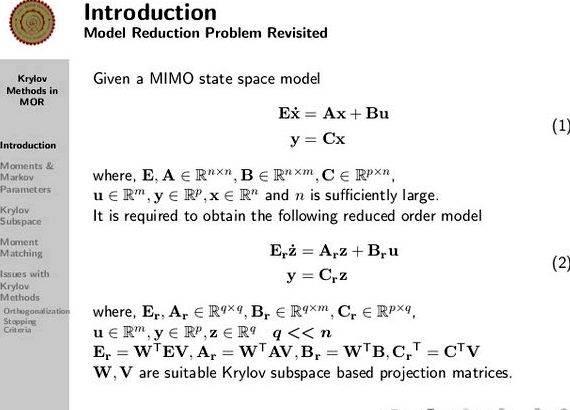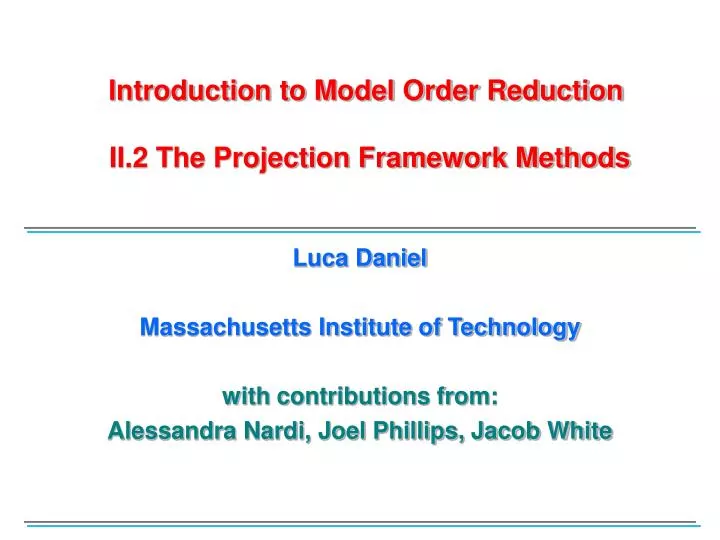
Buying options
Master thesis at IRS (group: “cooperative systems”) Research assistant (since 08/14): Chair of Automatic Control (Prof. Dr.-Ing. habil. B. Lohmann) Technical University of Munich blogger.com@blogger.com blogger.com Research interests: Systems theory, model order reduction, nonlinear dynamical systems, Krylov subspace methods 2 Brief personal In this paper we give an overview of model order reduction techniques for coupled systems. We consider linear time-invariant control systems Estimated Reading Time: 11 mins Here V and U are matrices, and x˜ and y˜ are vectors of the reduced state variables. Together, these terms approximate the inputs x and outputs y as a weighted sum of thecolumnsof V and blogger.com: R.J. Dedden
Model Order Reduction (MOR) techniques for parameterized Partial Differential Equations (PDEs) offer new opportunities for the integration of models and experimental data. First, MOR techniques speed up computations allowing better explorations of the parameter space Abstract This Chapter offers an introduction to Model Order Reduction (MOR). It gives an overview on the methods that are mostly used. It also describes the main concepts behind the methods and the properties that are aimed to be preserved. The Sections are in a prefered order for reading, but can be read independentlty We argue that much more complex problems can be addressed by making use of current computing technology and advanced algorithms, but that there is a need for model order reduction in order to cope with even more complex problems. We also go into somewhat more detail about the question as to what model order reduction is. Keywords Transfer Function

Holstenhofweg 85, Hamburg Model order reduction (MOR) is commonly used to approximate large-scale linear time-invariant dynamical systems. A new feed unit based on a compliant mechanism consisting of flexure hinges can be described by a discrete system of n ordinary differential equations Model Order Reduction Using LMI By Mohammed S. R. Abu Hatab Supervisor Dr. Hatem Elaydi \A Thesis Submitted in Partial Fulflllment of the Requirements for the Degree of Master of Science in Electrical Engineering." - ii. Abstract In this thesis, the problem of Frobenius Hankel (FH) norm, H2 norm and H1 norm In this paper we give an overview of model order reduction techniques for coupled systems. We consider linear time-invariant control systems Estimated Reading Time: 11 mins

We argue that much more complex problems can be addressed by making use of current computing technology and advanced algorithms, but that there is a need for model order reduction in order to cope with even more complex problems. We also go into somewhat more detail about the question as to what model order reduction is. Keywords Transfer Function Model Order Reduction (MOR) techniques for parameterized Partial Differential Equations (PDEs) offer new opportunities for the integration of models and experimental data. First, MOR techniques speed up computations allowing better explorations of the parameter space Model Order Reduction Using LMI By Mohammed S. R. Abu Hatab Supervisor Dr. Hatem Elaydi \A Thesis Submitted in Partial Fulflllment of the Requirements for the Degree of Master of Science in Electrical Engineering." - ii. Abstract In this thesis, the problem of Frobenius Hankel (FH) norm, H2 norm and H1 norm
Here V and U are matrices, and x˜ and y˜ are vectors of the reduced state variables. Together, these terms approximate the inputs x and outputs y as a weighted sum of thecolumnsof V and blogger.com: R.J. Dedden In this paper we give an overview of model order reduction techniques for coupled systems. We consider linear time-invariant control systems Estimated Reading Time: 11 mins Model Order Reduction Using LMI By Mohammed S. R. Abu Hatab Supervisor Dr. Hatem Elaydi \A Thesis Submitted in Partial Fulflllment of the Requirements for the Degree of Master of Science in Electrical Engineering." - ii. Abstract In this thesis, the problem of Frobenius Hankel (FH) norm, H2 norm and H1 norm
No comments:
Post a Comment